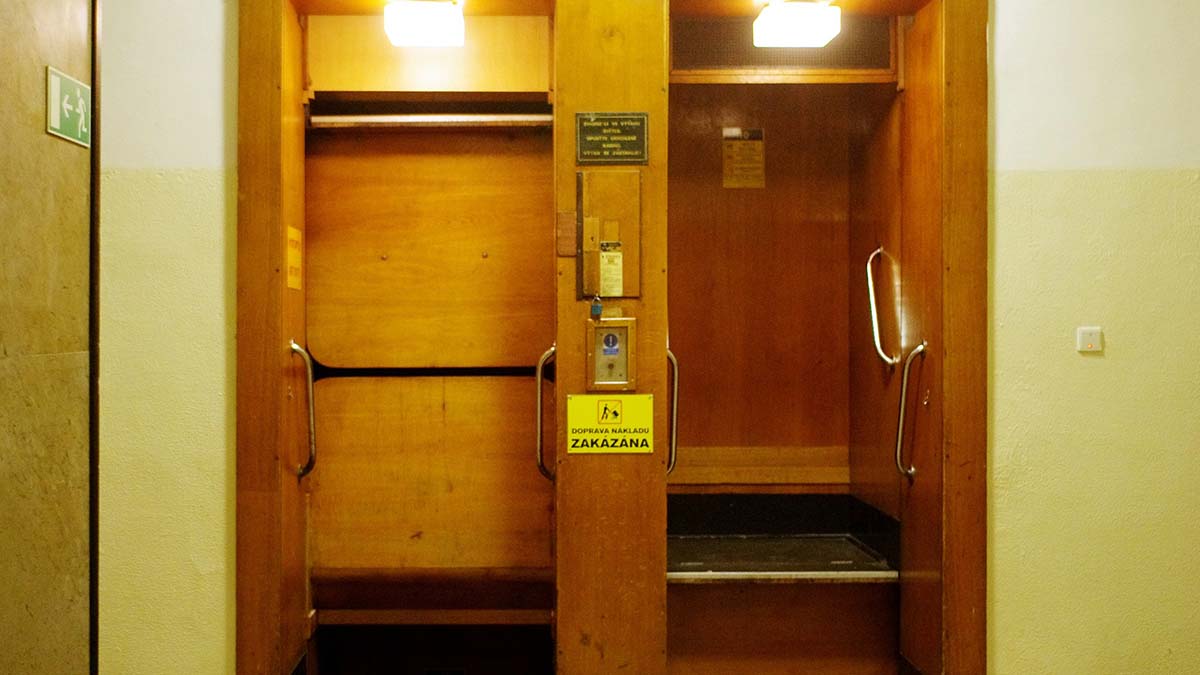I was late.
I’d arrived in Prague just that week, in 1993, and I was still figuring out how to get around. I thought an hour was tons of time to get to ÄŒeský rozhlas – the building that housed the headquarters of Czech Radio. But I got turned around at the top of Wenceslas Square and I ate up my buffer searching. So, I didn’t have any time to lose to get to my meeting with the director of the English language service.
As I power-walked by the corner, I did notice you could still see some of the bullet pockmarks in the building, dating back to the Prague Spring, in 1968. But that wasn’t the only old thing that was going to take me aback.
The elevator – a paternoster – was a thing of nightmares

The paternoster is an old lift technology that used a loop of open compartments, slowly rotating from floor-to-floor. Without stopping. There was no instrumentation. There was a sign that said “Pozor!” and then a whole sentence in Czech. It could have said anything. (What it did say was “Warning!” and then instructions on how there could never be more than two people in a car, nor could they exceed a certain weight total.)
I was late. My instructions for finding the English Language Service offices were simple: “Get on the lift. Turn left on the fourth floor. Third door on the right.” There was no time to figure out where the stairs were, and then backwards engineer the directions to find the right place. I didn’t even have an office number, and I certainly didn’t have enough Czech to ask for directions. And even if I did, I knew I wouldn’t understand the reply. I was a stereotypical Canadian, so I’d learned the terms for please (prosÃm), thank you (dÄ›kuji) and beer (pivo), but that was it.
Apparently, they call these lifts a paternoster because when you look at the loop of compartments, they look a bit like rosary beads. I’m told by my Catholic friends, you’d use a rosary while saying the Our Father (Pater Noster) prayer. Maybe the Hail Mary, too?
I suspect they were called that because, let’s face it, one slip or bad step, and you’d be going to meet Our Father right soon.
Timing, as they say, is everything
I waited for a minute to see how other people managed this conveyance from hell. Nobody was freaking out. They just kind of stepped onto it as the opening appeared. It was weird to see heads, torsos, then legs and feet slowly disappear.
Okay, let’s do this, I thought. I waited for my moment, and stepped onto the thing. It was fine! It was odd, watching the floor slowly disappear, to be replaced with a solid wall that passed in front of me. I was tempted to touch the wall, and had a horrific vision of my hand getting stuck to it, and then my arm turning into paste as the paternoster relentlessly squished me. Would my thick skull jam the mechanism?
I realized that I hadn’t watched anyone get off the damned thing. Was there a trick to it? How would I know when to step off? Would I get a warning?
Very slowly, a sign that said “1. Patro” slipped by. First floor? Yes, of course. This was Europe, that’s how they rolled. There’s a ground floor, then a first floor. Right. It was clear the paternoster was moving at a glacial pace. I would be fine.
Could I stick the paternoster landing?
Finally, “4. Patro” appeared, and it was time to get ready. I psyched myself up, as the wall gave way to an opening. Slowly. “Oh my God,” I said. That was definitely why it was called a paternoster. You had to invoke God’s name to get off this thing. I had to duck my head as I went through the opening. As I started to fall, I realized I’d exited to0 soon. I was done for. Oh well, I’d had a good run.
My foot landed with a slap on the tiled floor, and forward motion carried me away from the damned elevator. I managed not to trip, or run into anyone in the hall. I broke into a cold, post-crisis sweat. I’d survived the bloody thing. The door to the office was exactly as described; I was so relieved, I wasn’t in the least bit nervous and I had a lovely chat with the director and his colleague. They offered me a job, which brought me back to the building once a week, to record my radio column, “Observer.”
I took the paternoster every time.*
Next time on Terrifying Conveyances: The Songthaew
In my new book, much of what happens to Maximilian Tundra centers around a variety of forms of transport, many of which are life-threatening. The inspiration for that had to come from somewhere, right? This series explores that. Now that you know the behind-the-scenes, go read Alpha Max! Learn more about the book here. Or buy the book here:
*This is the oldest paternoster in the Czech Republic. It’s still operational, but no longer open to terrorize the public.
Image Credits: “P-lift in Prague” by JanneM is marked with CC BY-NC-SA 2.0. Animated gif by: RokerHRO, shared under a CC-3 license.

